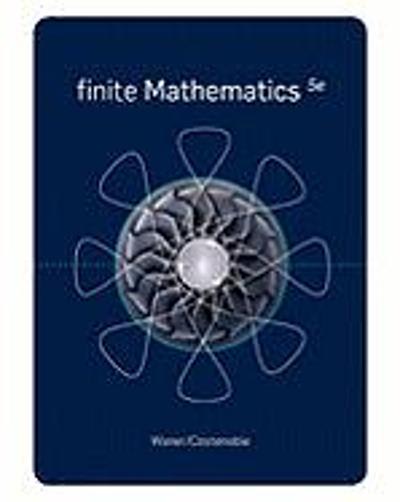Question
PHC 6000 Epidemiology for Public Health Professionals PROBLEM SET # 2 (PLEASE SHOW-ALL WORK TO GET ANY CREDIT) Questions 1-3 are based on the following
PHC 6000 Epidemiology for Public Health Professionals
PROBLEM SET # 2
(PLEASE SHOW-ALL WORK TO GET ANY CREDIT)
Questions 1-3 are based on the following information:
The death rate per 100,000 for lung cancer is 7 among non-smokers and 71 among smokers. The death rate per 100,000 for coronary thrombosis is 422 among non-smokers and 599 among smokers. The prevalence of smoking in the population is 55%.
- What is the relative risk of dying for lung cancer and coronary thrombosis for a smoker compared to a non-smoker? ( 4 points) 10.1 for lung cancer and 1.4 for coronary thrombosis
- Among smokers, what is the etiologic fraction of lung cancer and coronary thrombosis due to smoking? ( 4 points)
3) What is the population etiologic fraction of disease due to smoking for lung cancer and for coronary thrombosis? ( 4 points)
Questions 4-6 are based on the following information:
In a population-based cohort study, an entire community was interviewed regarding smoking habits and then followed for one year. Upon ascertainment of all lung cancer deaths, the investigator obtained the following data:
| Number of individuals | Lung cancer deaths | |
| Smokers | 24,500 | 15 |
| Non-smokers | 10,500 | 2 |
4) Calculate the proper measure of association of smoking and lung cancer death. Interpret your results. ( 4 points)
5) Calculate the population risk difference. Interpret your results. ( 4 points)
6) Calculate the population etiologic fraction for smoking and lung cancer based on these data. Interpret your results. ( 4 points)
Questions 7-12 are based on the following information:
Helical CT scanning may be a more sensitive screening test for lung cancer than other tests such as conventional chest films or nuclear medicine studies.The Gold Standard for lung cancer diagnosis is finding cancer cells in bronchial washings. In a study, 200 individuals were screened for lung cancer using helical CT. In this population, 40 out of 43 who screened positive for lung cancer actually had the disease based on bronchial washings while 10 of 157 screened negative for the disease by helical CT actually had the disease based on bronchial washings.
- Construct a 2 X 2 table showing Screening test vs. Gold Standard. Set up a 2 X 2 like Figure 11.4 in the text.
( 4 points)
| Gold Standard (Bronchial Washing) | |||||
| Present | Absent | Total | |||
Test result CT Scan | Positive | a = (True positives) | b = (False Positives) | (a + b) = | + Predictive Value
|
| Negative | c = (False Negatives) | d = (True Negatives) | (c + d ) = | - Predictive Value
| |
| Total | (a + c) = | (b + d) = | Grand Total (a + b + c + d) | ||
| Sensitivity | Specificity |
- Calculate the sensitivity ( 4 points)
- Calculate the specificity ( 4 points)
10) Calculate the positive and negative predictive value ( 4 points)
11) Calculate the prevalence ( 4 points)
- Calculate the accuracy ( 4 points)
Questions 13-15 are based on the following information:
You work at a screening center that can process 1,000 people per week. Assume you are attempting the early detection of a disease with a prevalence of 2% and that your test has a sensitivity of 95% and a specificity of 90%.
Key facts:
- 1,000 tests per week
- Early detection
- 2% prevalence
- 95% sensitivity
- 90% specificity
13. Complete the following 2 x 2 table (4 points)
| Gold Standard | |||||
| Present | Absent | Total | |||
Test result | Positive | a = (True positives) | b = (False Positives) | (a + b) = | + Predictive Value
|
| Negative | c = (False Negatives) | d = (True Negatives) | (c + d ) = | ||
| Total | (a + c) = | (b + d) = | Grand Total (a + b + c + d) | ||
14. Calculate the positive predictive value (4 points)
15. Interpret the results (4 points)
Step by Step Solution
There are 3 Steps involved in it
Step: 1

Get Instant Access to Expert-Tailored Solutions
See step-by-step solutions with expert insights and AI powered tools for academic success
Step: 2

Step: 3

Ace Your Homework with AI
Get the answers you need in no time with our AI-driven, step-by-step assistance
Get Started


